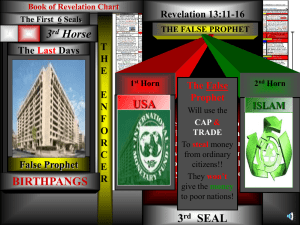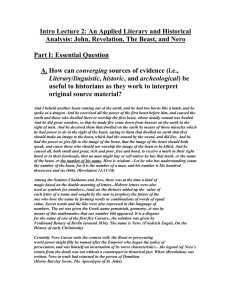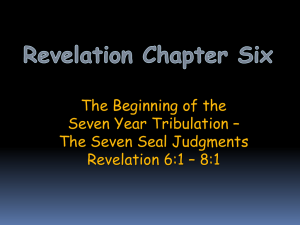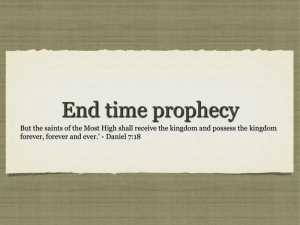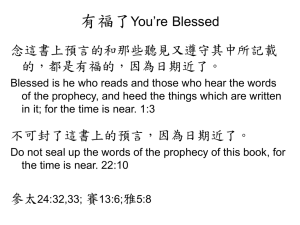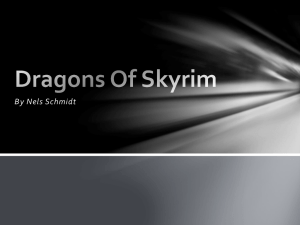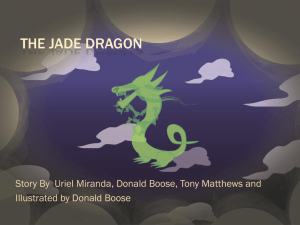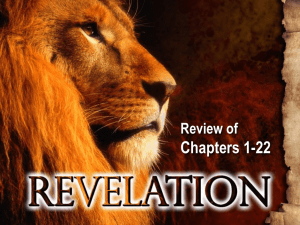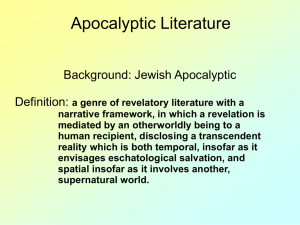The Book of Revelation
advertisement
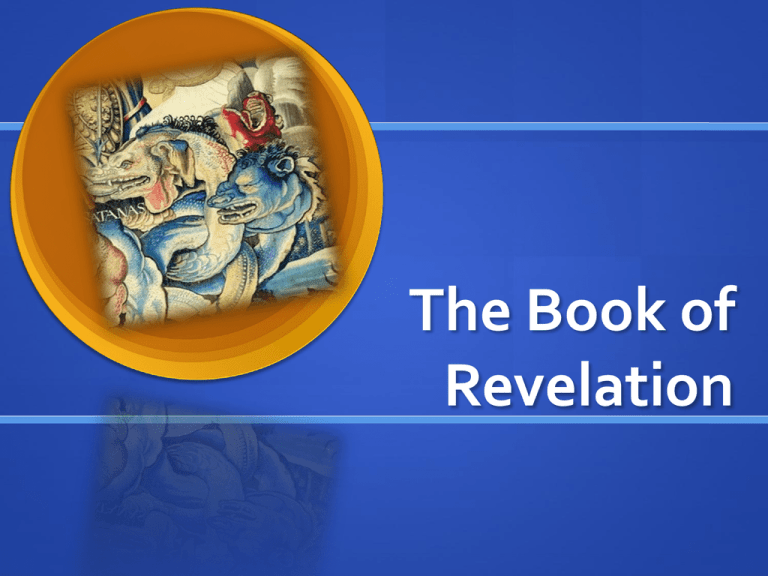
The Book of Revelation Background-Revelation Reason for being written To comfort Christians being persecuted by the Romans This imagery pitched them out of their terrifying reality Provided strongly imaginative imagery of God’s ultimate salvation Jesus, the Sacrificial Lamb, conquered death Apocalypse concerns the end of time Comes from a Greek word for “unveiling” or “revealing” Apocalypses are most often addressed to those living in times of suffering and persecution. Revelation is widely popular for the wrong reasons, for a great number of people read it as a guide to how the world will end, assuming that the author was given by Christ detailed knowledge of the future that he communicated in coded symbols. e.g. – preachers have identified the Beast from the Earth whose number is 666 as Hitler, the Pope, and Saddam Hussein, and have related events in Revelation to the Communist Revolution, the atom bomb, etc. Apocalypse Apocalypses through the Ages The 19th and the 20th centuries have seen many interpreters of prophecy who used calculations from Revelation to predict the exact date of the end of the world. In every generation since the book was written, Christians have argued that its vivid description of catastrophic events would happen in their own day. Background Written between 90-100 CE Addressed to Christian churches in Asia minor “John, to the seven churches that are in Asia” (Rev. 1:4) It means that Rev. is a book for its own time, and that it was written to communicate with Christian congregations in first-century Asia Minor (modern-day Turkey) Approaching the book as a historical book Those who lived in John’s time understood the message of the book by studying the language and literature of the ancient world not by watching the news Author The seer of Revelation four times calls himself John. who was neither John son of Zebedee nor the writer of the Johannine Gospel or of the Epistles. The author of Revelation did not know how or when the world will end, and neither does anyone else. The author directs his anger against the political institutions of his day, especially the Roman government, which was responsible for the oppression and suffering of the people of God. Christianity was an oppressed and persecuted religion. In his view, this government will not survive, since God was soon going to destroy it. Why beasts? The Romans killed Christians who refused to deny Jesus Often, these Christians were made to fight wild beasts in the arenas throughout the Empire While Christians on earth were fighting worldly beasts, God in heaven and his angels were fighting otherworldly beasts THEMES: The 666 The woman and the Dragon The 7 seals The number of the beast 666 Read warm-up Gematria John invites the readers to “calculate the number of the beast, for it is the number of a person” (13:18) The text apparently assumes that readers are familiar with gematria which is the practice of adding up the numerical values of the letters in a word/name. In antiquity, the letters of the alphabet had numerical values ascribed to them. By explaining the 666 is the “number of a person,” John implies that 666 is the sum of the values of the letters in a person’s name. A common practice The practice of gematria was not uncommon On the level of street culture, a graffiti artist used a number for the name of his beloved on the wall: “I love her whose number is 545” On the level of religious writing, Christian authors delighted in showing that the name “Jesus” in Greek letters added up to 888. The Number of the beast 666 Antichrist refers to someone that does not believe in God. The beast is described as God’s enemy Who controls the world, exploits its people, and kills the saints. So, the beast may be another image of the Roman Empire. If so, then the heads would presumably be the rulers of the empire, some of whom demand to be worshiped. Nero was seen as the archenemy of the Christians Nero ruthlessly “made war on the saints,” condemning some to be torn apart by wild dogs, others to be crucified, and still others to be burned alive It seems that 666 corresponds to Neron Kaisar Which is the Hebrew form of the name Nero Caesar By the time Revelation was written, Nero was dead, but John portrays the beast as a Nero figure in order to underscore the threat that it poses. 666 The triple six connotes imperfection The # 666 implies that the beast signifies unfulfillment and destruction. Other candidates for 666 Pope Benedictus Computer Barney the dinosaur The woman and the dragon handout Popular culture John’s audience lived within a wider culture that had its own heroes and image makers, its rituals, stereotypes, and graffiti. Leto vs. Python A common story of the battle between good and evil that circulated during John’s time included a dragon named Python and a woman named Leto. When Leto became pregnant by the god Zeus, the dragon pursued her in order to kill her and her child. The north wind rescued Leto by carrying her away. She eventually found refuge on the island of Delos. Apollo = Nero In Delos, Leto gave birth to Apollo and Artemis. Four days later, Apollo set off in pursuit of the dragon, soon slaying the creature to avenge his mother. Roman emperors were able to put the tale to good use by associating themselves with Apollo. Citizens of the empire could be expected to identify the woman in the story with the goddess Roma, who was the queen of heaven. Her son would be the Roman emperor. The emperor Nero liked to present himself in the guise of Apollo When John tells about a pregnant woman and a dragon, the seven churches understand that John’s version reverses the tale. The woman in labor is not a pagan goddess but the people of God (the church); the child is not the emperor but Christ; and the dragon represents the forces that oppose Christ and threaten his church. 7 Seals act. The seven seals •6:1-17 • The text is not telling us to expect the end times •The horsemen represent conquest, violence, economic hardship, and death. •These were genuine threats for people in the first century and they have remained threats for people in subsequent centuries The horsemen •The four horsemen are designed to shatter the illusion that people can find true security in the borders of a nation or empire, in a flourishing economy, or in their own health. • The first horseman with his bow appears in the background of the picture, furthest away from the viewers. This placement is suggestive because fear of conquest by a foreign power is often furthest away from readers’ mind. The first horseman was given the crown of victory, implying that his power to conquer came from God The second horseman The second horseman brings the threat by pointing to the violence that people perpetrate on “one another” The rider stands for the threat of violence that can erupt within one’s own society. The second horseman was permitted to take peace from the earth, presumably by God, and he was given a sword to accomplish the task The third horseman brings the threat still closer by depicting economic insecurity The rider holds a pair of scales, like those used in commerce, and issues a threat of economic hardship. This horseman is the largest and most prominent suggesting that economic difficulties loom largest in most people’s mind. The four horseman Represents death It is the lower foreground of the picture with the creature that represent Hades. The realm of dead. Sheol in Hebrew Sits on a green horse The fourth horseman was given authority to inflict death
